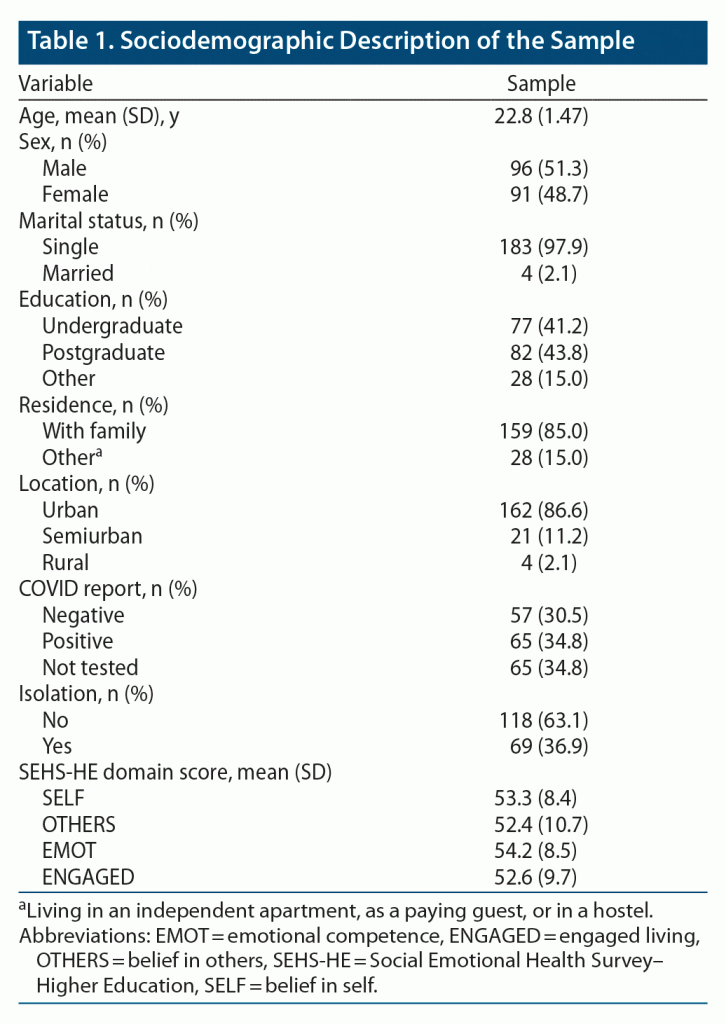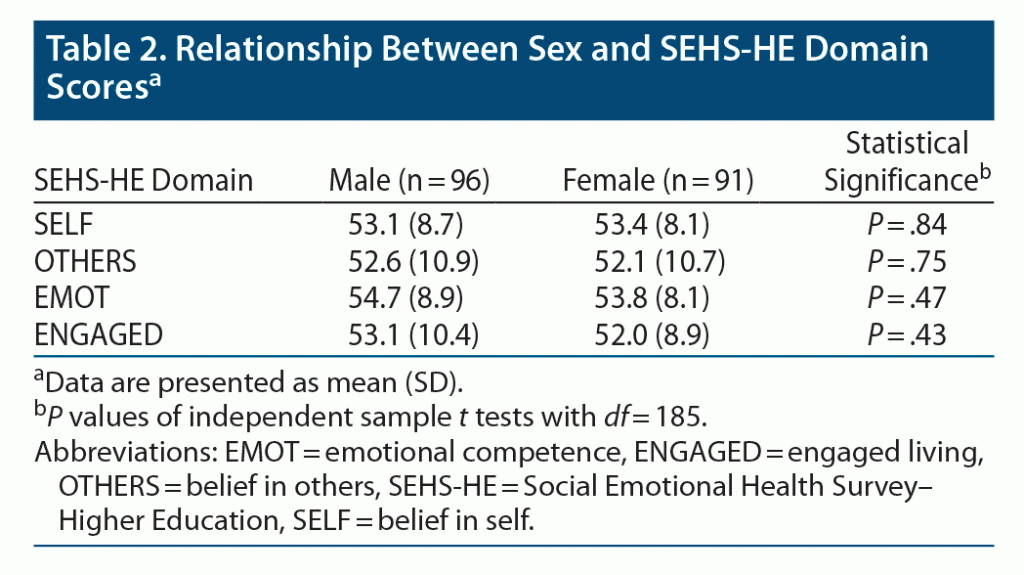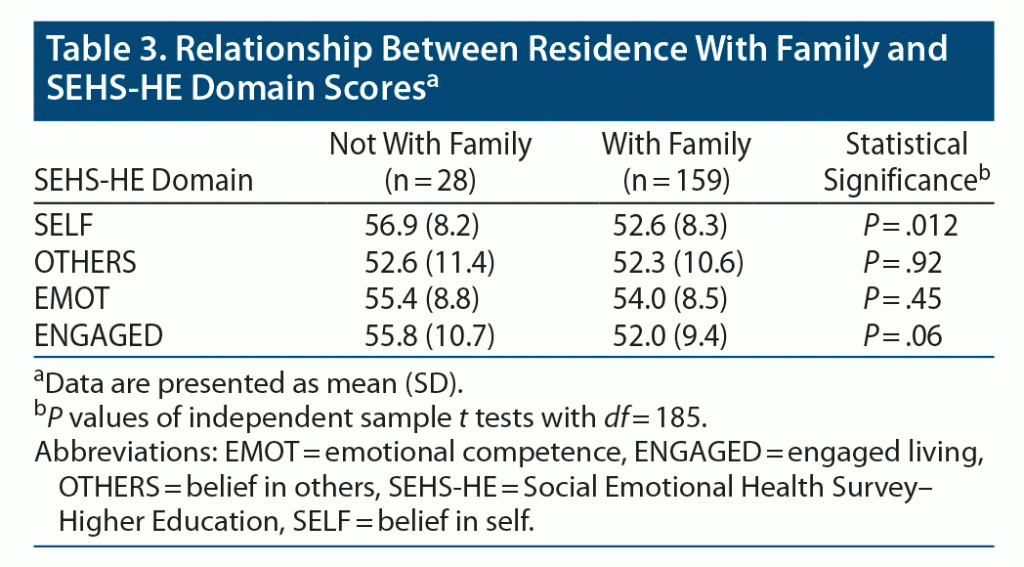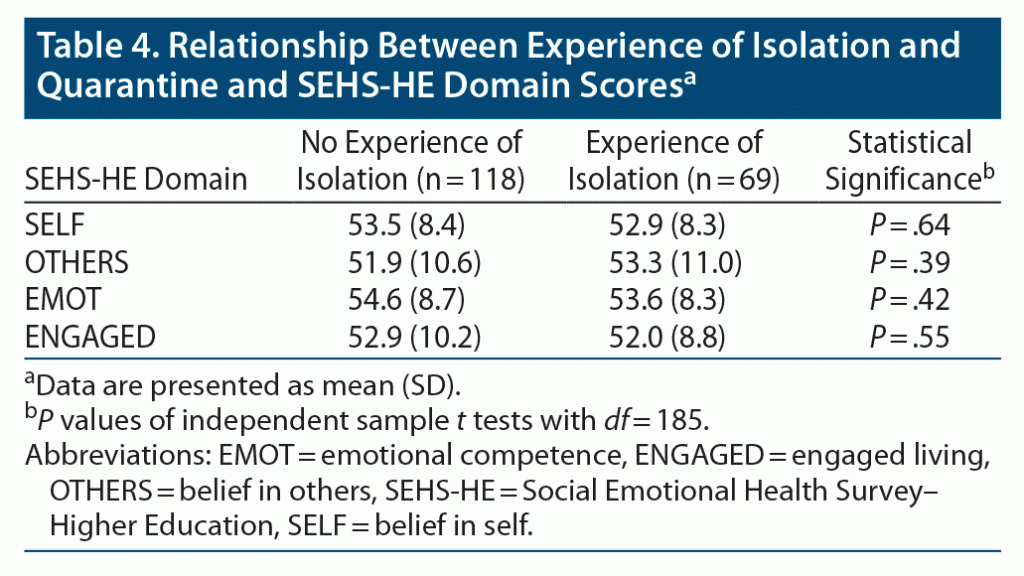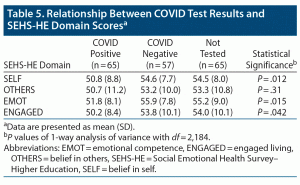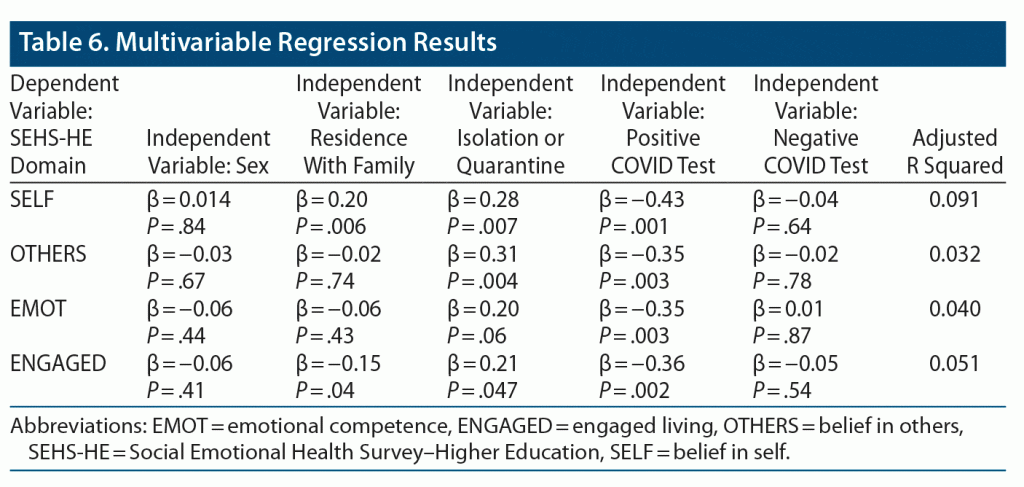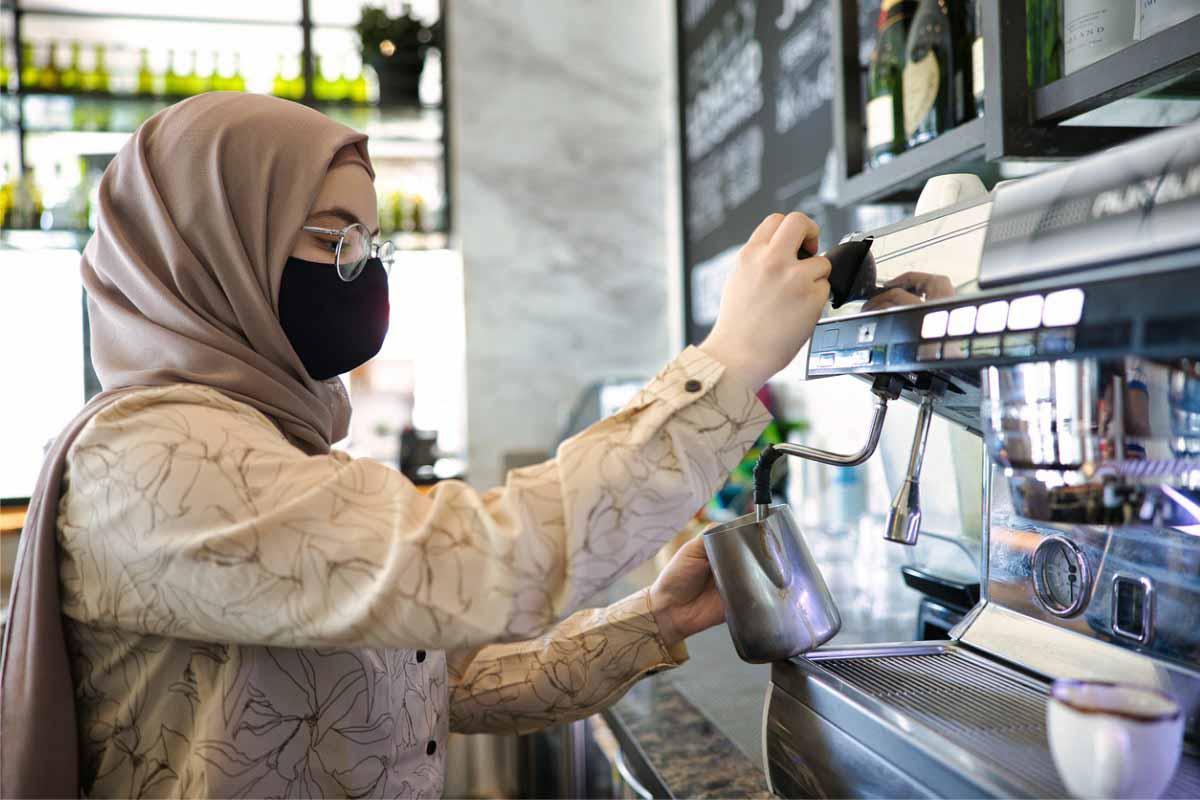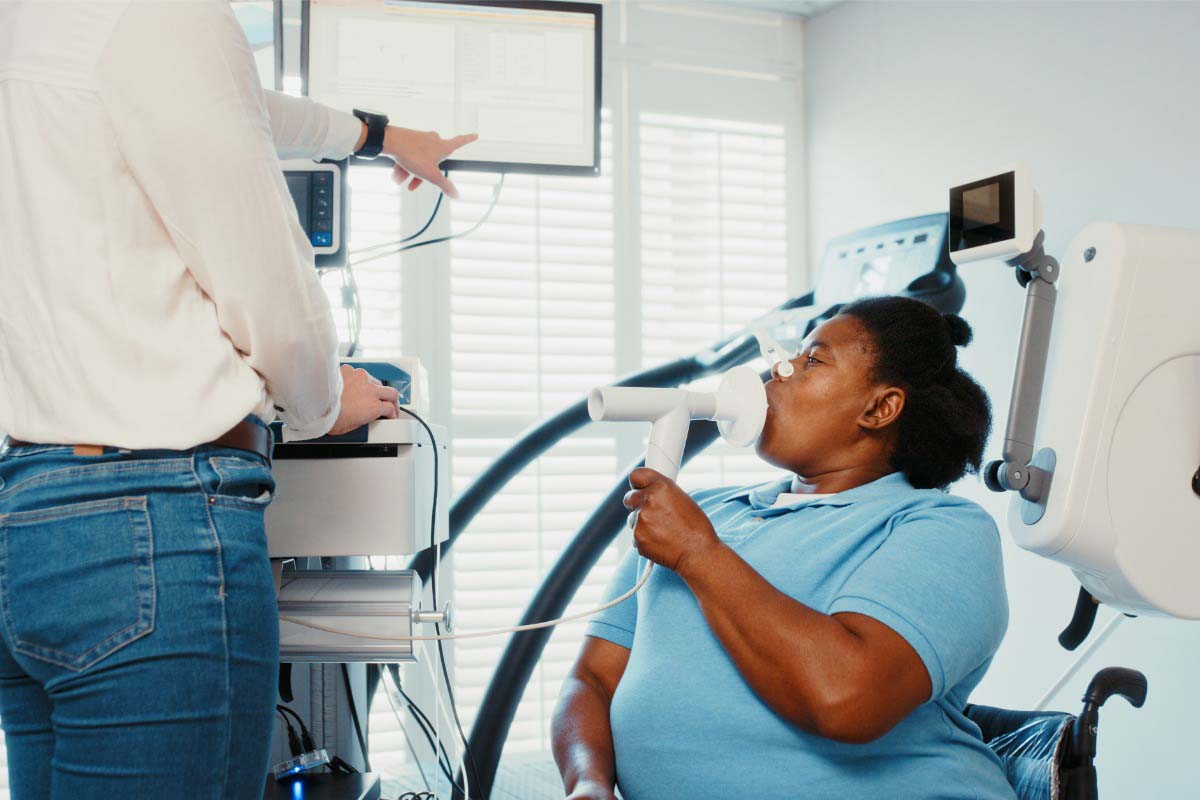ABSTRACT
Objective: Research on effects of the coronavirus disease 2019 (COVID-19) pandemic on the mental health of youth have mostly focused on the occurrence of negative states such as anxiety and depression. The objective of this study was to assess the social and emotional health of university students in India, as influenced by COVID-19 test results and the experience of isolation or quarantine.
Methods: A cross-sectional online survey was conducted in India during July and early August 2021 among university students aged 20–25 years. The Social Emotional Health Survey–Higher Education (SEHS-HE) was used to assess 4 domains: belief in self, belief in others, emotional competence, and engaged living.
Results: There were 187 respondents from 78 institutions in 14 of 29 states of India. The sample was 51% male. The mean SEHS-HE scores were approximately 75% of the maximum score in each domain. In multivariable regression analysis, sex, residence with family, and a negative COVID-19 report had little effect on SEHS-HE domains. COVID-19 positivity was associated with significantly lower scores on all domains (P < .01). Isolation/quarantine was associated with significantly or near-significantly higher scores on all domains (P < .01). In all cases, β coefficients and the proportion of the variance explained by the regression were small.
Conclusions: Major pandemic-related internal and environmental determinants of SEHS-HE remain to be identified. Strategies to improve the well-being of college students should be directed toward those who have tested positive for the disease. The experience of isolation/quarantine is not pathoplastic.
Prim Care Companion CNS Disord 2022;24(3):22m03247
To cite: Sarkar A, Jasmine E, Thomas SL, et al. Markers of social and emotional health in college students during the COVID-19 pandemic. Prim Care Companion CNS Disord. 2022;24(3):22m03247.
To share: https://doi.org/10.4088/PCC.22m03247
© Copyright 2022 Physicians Postgraduate Press, Inc.
aDepartment of Psychology, Indian Institute of Psychology and Research, Bangalore, India
bDepartment of Clinical Psychopharmacology and Neurotoxicology, National Institute of Mental Health and Neurosciences, Bangalore, India
*Corresponding author: Chittaranjan Andrade, MD, Department of Clinical Psychopharmacology and Neurotoxicology, National Institute of Mental Health and Neurosciences, Bangalore 560 029, India ([email protected]).
The demographics of India are dominated by youth. Among youth, students spend a considerable part of their day in a school or college and, afterward, with their peer groups. College students also spend time with each other in the evening. There are many benefits associated with these activities: students gain academic learning, acquire social skills, form peer groups and relationships with members of the opposite sex, and learn to cope with the demands of everyday life. All of this was disrupted by the academic and social restrictions imposed by the coronavirus disease 2019 (COVID-19) pandemic. The entire population was affected by lockdown, but the social and emotional growth of students was particularly affected not only by the lockdown but also by the prolonged closure of educational institutions after the restrictions were lifted.1,2
During the COVID-19 pandemic, studies3–5 have examined the mental health of Indian college students, focusing on the occurrence of negative states such as anxiety and depression. However, other aspects of Indian college students’ mental health have been neglected, especially social and emotional health and specifically in the context of testing positive for COVID-19 and experiencing isolation or quarantine. It is likely that COVID-19 positivity and isolation/quarantine constitute additional stressors and thus would have a demonstrable impact on measures of health.6 We therefore conducted what we believe to be the first study of the social and emotional health of university students in India, as influenced by COVID-19 test results and the experience of isolation or quarantine.
METHODS
Study Design and Setting
This study was planned as a cross-sectional, online survey of college students in India. The study was approved by the Research Approval Committee, Indian Institute of Psychology and Research, Bangalore. The study was conducted during July and early August 2021, when parts of India were under full or partial lockdown due to the second wave of COVID-19 that was spreading through the country.
Sample
The sample comprised male and female students aged 20–25 years, who were residents of India, enrolled in graduate or postgraduate courses, and pursuing their studies online or in person, depending on regulations within their educational institutions and in their part of the country. The sample was identified through announcements in social media (eg, email groups, Facebook). The data were collected using Google Forms, which saves data only in those forms that have been completed with no missing entries in mandatory fields. In this survey, all fields were set as mandatory.
Assessments
The students were assessed using a short form that obtained informed consent and captured important sociodemographic descriptors, as well as information related to COVID testing and the experience of physical isolation. Respondents also completed the Social Emotional Health Survey–Higher Education (SEHS-HE) version.7
The SEHS-HE is a 48-item list of statements, each of which must be self-rated by respondents along an anchored 6-point scale ranging from 1 (very much unlike me) to 6 (very much like me). The SEHS-HE assesses 4 domains: belief in self (SELF), belief in others (OTHERS), emotional competence (EMOT), and engaged living (ENGAGED). Each domain is independent and is assessed through 12 statements; whereas there is no summated total score for the SEHS-SE, the maximum total score for each domain is 72.
The SELF domain assesses self-efficacy, persistence, and self-awareness; OTHERS assesses family support, institutional support, and peer support; EMOT assesses cognitive reappraisal, empathy, and self-regulation; and ENGAGED assesses gratitude, zest, and optimism. In each domain, higher scores suggest better functioning.
Statistical Methods
Descriptive statistics were computed and presented as mean (SD) or as frequency count (percentage). Exploratory bivariate comparisons between independent variables (sex, residence, COVID test results, and experience of isolation) and dependent variables (SEHS-HE domains) were performed using the independent sample t test or 1-way analysis of variance. These independent variables were selected based on what we believed could influence social and emotional health.
The defining analysis involved separate exploratory multivariable linear regressions with domain as the dependent variable and sex (male and female), residence (staying or not staying with family), COVID test results (previously or currently positive, negative, or not tested), and experience of isolation (yes or no) as the independent variables. For all analyses, α for statistical significance was conservatively set at P < .01 (and not P < .05), as this was an exploratory analysis with many hypotheses examined in the absence of a stated primary hypothesis.
RESULTS
During a period of 4 weeks, there were 187 respondents from 78 institutions in 14 of 29 states of India. The mean age of the sample was approximately 23 years. Male and female respondents were roughly equal in number. The respondents were mostly single and living with their family in an urban setting. A roughly equal number of respondents had tested negative or positive for COVID-19 during the past 2 month or had not been tested. About a third of the sample had experienced isolation or quarantine related to COVID-19. The mean SEHS-HE scores were about 75% of the maximum score in each domain. A detailed description of the sample is provided in Table 1.
Bivariate relationships between the independent variables of interest and the SEHS-HE domains are presented in Table 2, Table 3, Table 4, and Table 5. In summary, respondent sex, residence with family, experience of isolation/quarantine, and COVID test results were not significantly associated with SEHS-HE domain scores at the conservative P < .01 threshold that was set to protect against a type 1 error.
The results of the multivariable regression analysis are presented in Table 6. This analysis elicited the unique effect of each of the independent variables. In summary, in multivariable analyses, sex (male vs female) and a negative COVID-19 test result did not significantly influence scores on any SEHS-HE domain. Residence with family was associated with a significantly higher score on only the SELF domain. Expectedly, COVID-19 positivity was associated with significantly lower scores on all domains. Surprisingly, the experience of isolation/quarantine was associated with significantly or near-significantly higher scores on all domains. In all cases, however, β coefficients were small (the highest was −0.43), indicating a small effect size, and the proportion of the variance explained by the regression was merely 3%–10%.
DISCUSSION
The COVID-19 pandemic and the associated experience of isolation/quarantine have had a deleterious effect on mental health. For example, in a study of 153 home-quarantined men and women, Das et al8 found that half of the sample experienced moderate to high levels of perceived stress, and a quarter had poor coping. Women experienced more stress, and in multivariable analysis, higher age, living in a joint family, and being a COVID-19 contact were each associated with moderate to severe stress. Youth in India have been less well studied. We therefore examined the effects of sex, residence with family, experience of isolation/quarantine, and COVID test results on domains of social and emotional health that we believed could help combat the adversities related to the pandemic.
Bivariate analyses identified no significant associations after applying a P value that protected against type 1 statistical errors. In multivariable analyses that identified the unique effects of the independent variables (Table 6), we found that the respondent’s sex, a negative COVID-19 test report, and residence with family each had little effect on SEHS-HE domains. COVID-19 test positivity was associated with poorer scores on all 4 domains of social and emotional health. The experience of isolation or quarantine was associated with higher social and emotional health scores. Effect sizes representing these associations were small. The variables examined explained only 3%–10% of the variance in SEHS-HE domains.
Findings of the Study
Sex was not associated with SEHS-HE domain scores (Table 6). Women do not commonly experience social equality in India, and so the finding that the respondent’s sex was not a marker of social and emotional health is reassuring. A possible explanation is that the student population is more inclusive of (less discriminatory against) women than the general population in India. A more likely explanation, however, is that sex differences are less likely to characterize social and emotional health when subjects reside with their families and enjoy family support, as in the case of 85% of the subjects in our study (Table 1).
We were surprised that residence with family was not associated with better social and emotional health. One possible explanation is that most of the respondents resided with their families; this may have reduced statistical power in the analysis. Another possible explanation is that the increased support obtained from families may have been offset by the friction generated by enforced isolation with the family during lockdown.9
A negative COVID-19 test report was not associated with better social and emotional health. The most likely explanation is that the relief associated with a negative report is short-lived and does not have a lasting impact on well-being.
Expectedly, COVID-19 test positivity was associated with significantly poorer scores on all SEHS-HE domains. All β coefficients were in the −0.35 to −0.43 range. Although this represents a small to medium effect size, the coefficients were larger for this variable than for any of the other variables studied. Clearly, a positive test report stresses the individual. It may result in or be associated with many adverse experiences: physical isolation, experience of illness, experience of residual symptoms after recovery, and infection of family members. All these adverse experiences can compromise social and emotional health.
Surprisingly, the experience of isolation or quarantine was associated with significantly or near-significantly higher scores on SEHS-HE domains, which was the opposite of what we expected after review of the literature.6 A possible explanation is that most of the respondents were no longer in isolation or quarantine at the time of completion of the survey, and thus their relief or successful overcoming of the challenges associated with isolation or quarantine may have improved their social and emotional well-being.
Strengths and Limitations
A strength of this study is that we were able to obtain a sample of respondents from several dozen universities in about half of the states in India allowing for generalization from sample to population, which would not have been possible if the sample had been drawn from only a few universities with narrower geographical dispersion. Also, this study is possibly, to the best of our knowledge, the first to use the SEHS-HE in the context of the impact of COVID-19 on youth.
A limitation of our study is that because it was conducted during a period of national partial to complete lockdown, the data were collected through an online survey, which is known to be associated with limitations.10 In defense, however, we received responses from 78 institutions in 14 of 29 states in India, which is a broad response base. Furthermore, we do not believe that there was bias due to self-selection of individuals emotionally adversely affected by their pandemic experiences, as the mean SEHS-HE scores were approximately 75% of the maximum score in each domain and not low. In any case, almost all the research conducted on the mental health and well-being of students in pandemic-hit India has been through online surveys. Another limitation is that we did not identify other determinants of social and emotional health as described by the SEHS-HE, including socioeconomic status, family size, and nature of the social circle, as this was out of the scope of the study.
CONCLUSIONS
The study findings suggest that major pandemic-related internal and environmental determinants of social and emotional health remain to be identified in college students. Strategies to improve the well-being of college students should be directed toward those who have tested positive for the disease because those students appear to be most vulnerable to poor social and emotional health.
Submitted: January 23, 2022; accepted March 25, 2022.
Published online: May 10, 2022.
Relevant financial relationships: None.
Funding/support: None.
References (10)

- Pandya A, Lodha P. Mental health of college students amidst COVID-19: implications for reopening of colleges and universities. Indian J Psychol Med. 2021;43(3):274–275. PubMed CrossRef
- Verma SK, Kumar BD, Chandra S, et al. Knowledge, attitude, and psychological effect on undergraduate/ postgraduate students in lockdown COVID-19 situation. J Pharm Bioallied Sci. 2021;13(suppl 1):S696–S698. PubMed CrossRef
- Saraswathi I, Saikarthik J, Senthil Kumar K, et al. Impact of COVID-19 outbreak on the mental health status of undergraduate medical students in a COVID-19 treating medical college: a prospective longitudinal study. PeerJ. 2020;8:e10164. PubMed CrossRef
- Chaudhary AP, Sonar NS, Tr J, et al. Impact of the COVID-19 pandemic on the mental health of college students in India: cross-sectional web-based study. JMIRx Med. 2021;2(3):e28158. PubMed CrossRef
- Mishra J, Samanta P, Panigrahi A, et al. Mental health status, coping strategies during Covid-19 pandemic among undergraduate students of healthcare profession. Int J Ment Health Addict. 2021;1–13. PubMed CrossRef
- Khan AH, Sultana MS, Hossain S, et al. The impact of COVID-19 pandemic on mental health and wellbeing among home-quarantined Bangladeshi students: a cross-sectional pilot study. J Affect Disord. 2020;277:121–128. PubMed CrossRef
- Furlong MJ, You S, Shishim M, et al. Development and validation of the Social Emotional Health Survey–Higher Education Version. Appl Res Qual Life. 2017;12(2):343–367. CrossRef
- Das S, Goel NK, Tyagi S, et al. Stress, coping, and resilience among home-quarantined persons during the COVID-19 pandemic: findings from a community study. Prim Care Companion CNS Disord. 2022;24(2):21m03080. PubMed CrossRef
- Joshi A. COVID-19 pandemic in India: through psycho-social lens. J Soc Econ Dev. 2021;23(suppl 2):1–24. PubMed CrossRef
- Andrade C. The limitations of online surveys. Indian J Psychol Med. 2020;42(6):575–576. PubMed CrossRef
Please sign in or purchase this PDF for $40.

